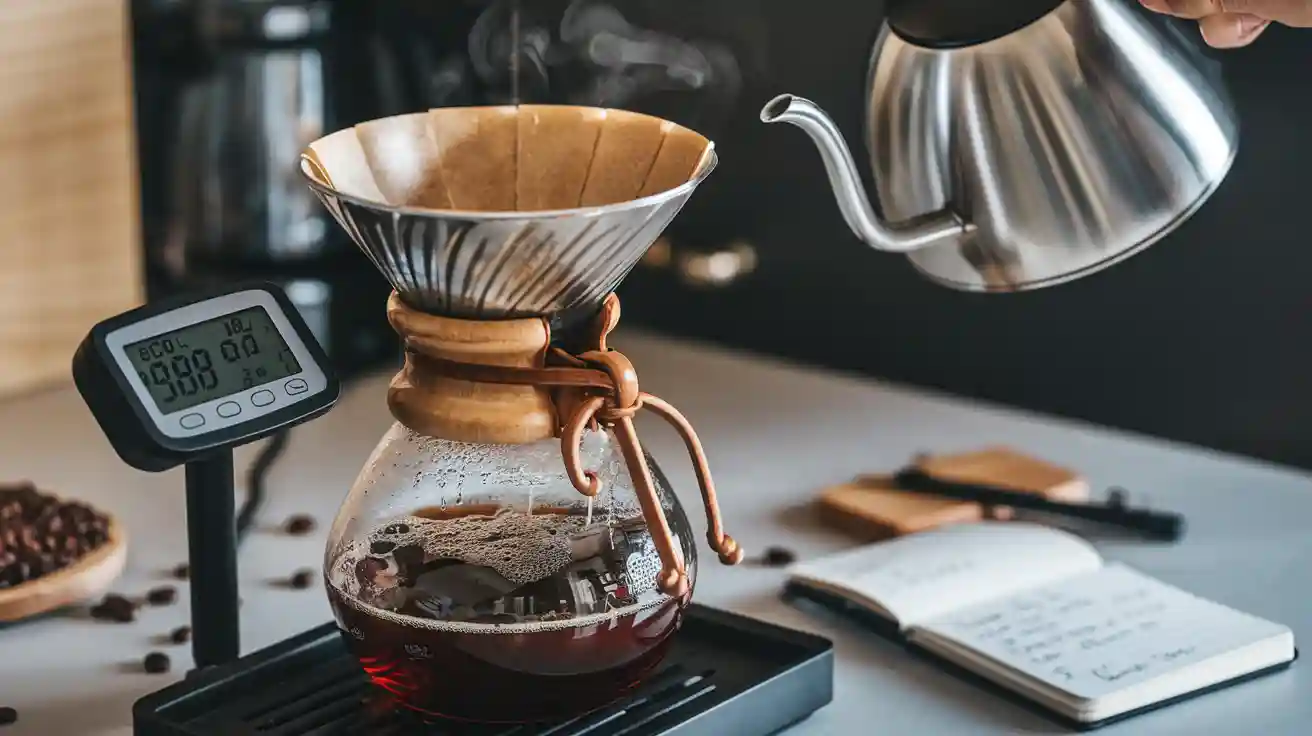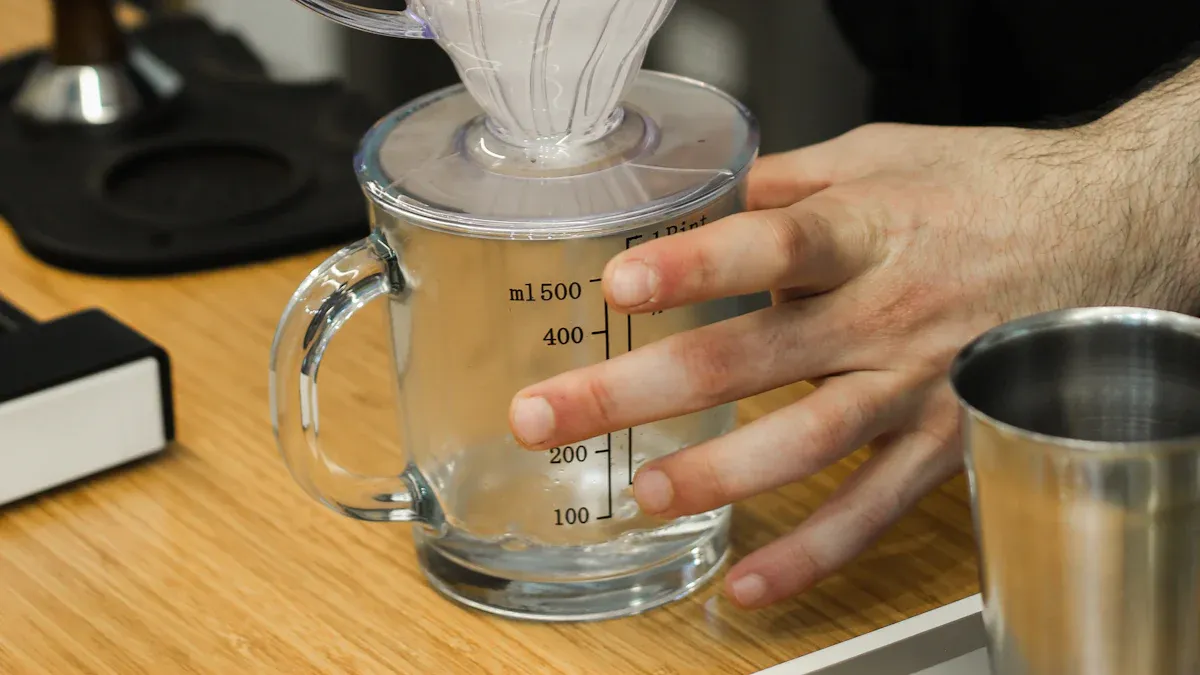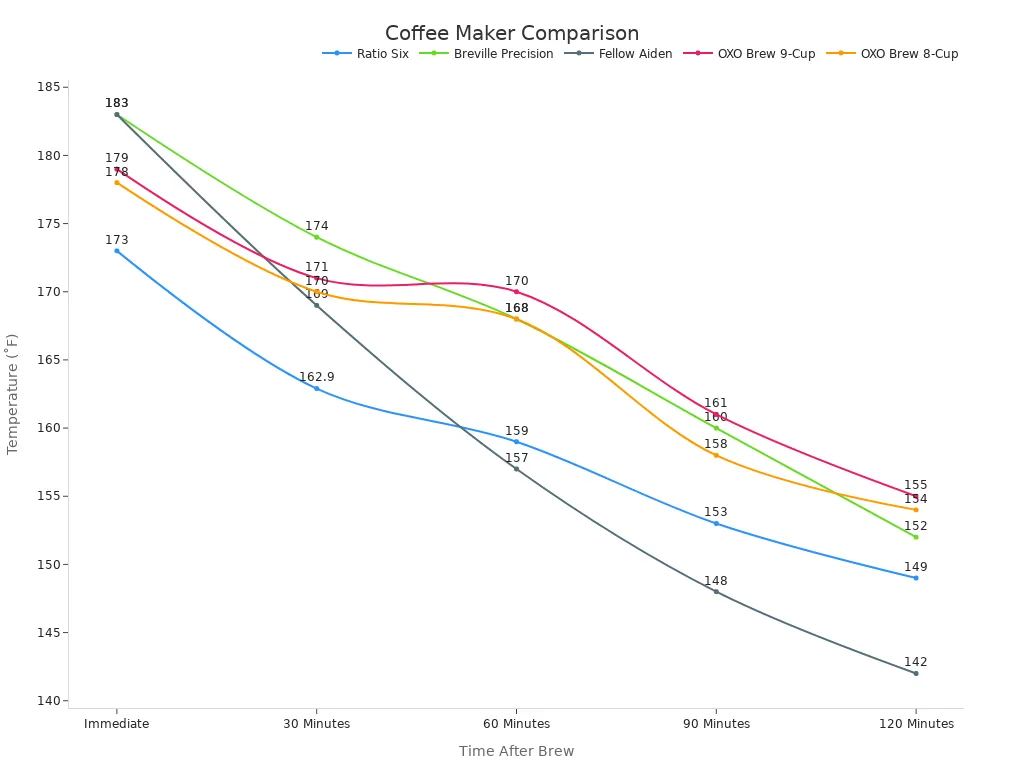
The secret to the ideal cup of coffee lies in precise temperature control, especially when using drip coffee makers. Brew temperature impacts flavor, aroma, and consistency by balancing the extraction of compounds. For drip coffee, slight variations can bring out caramel, nutty, or citrus notes. With the right tools, including high-quality drip coffee makers, you can master perfect drip coffee every time.
The Science of Coffee Brewing
Coffee Extraction and Solubility
The brewing process is a delicate dance of chemistry and physics. Coffee extraction refers to the process of dissolving soluble compounds from ground coffee beans into water. These compounds include caffeine, acids, oils, and sugars, which contribute to the coffee flavor and aroma. The solubility of these compounds depends heavily on temperature.
- During coffee brewing, higher temperatures increase the solubility of compounds like caffeine. For example:
| Temperature (°C) | Caffeine Solubility (mg/mL) |
|——————-|——————————|
| 20 | 1.46 |
| 80 | 180 |
| 100 | 670 |
This table shows how caffeine dissolves more effectively at higher temperatures, making temperature control essential for achieving the desired flavor intensity.
The mineral composition of water also plays a role in coffee extraction. Studies reveal that water with low bicarbonate levels and high magnesium content enhances flavor extraction, allowing you to experience the full spectrum of coffee flavor.
Temperature’s Role in Flavor Profiles
Temperature is the unsung hero of coffee brewing. It directly influences the release of volatile compounds, which shape the coffee flavor and aroma. As the temperature rises, these compounds are released more dynamically, creating a richer and more intense flavor profile.
Tip: Experimenting with serving temperatures can help you discover new dimensions of coffee flavor. A slight adjustment can bring out hidden notes like citrus, caramel, or nuttiness.
The brewing process also benefits from precise temperature control. It ensures that the coffee flavor remains consistent, allowing you to enjoy the same delightful taste with every cup.
Balancing Extraction: Avoiding Over- and Under-Extraction
Controlled extraction is the key to achieving a balanced cup of coffee. Over-extraction occurs when water dissolves too many compounds, leading to a bitter taste. Under-extraction happens when not enough compounds are dissolved, resulting in sourness.
- Balanced extraction avoids these extremes and creates a harmonious flavor profile.
- Low extraction yields can leave your coffee tasting incomplete, much like listening to music with distorted sound quality.
- Average extraction yields provide a well-rounded flavor, ensuring that every sip is enjoyable.
By mastering the brewing process and maintaining precise temperature control, you can achieve the perfect balance in coffee extraction. This balance unlocks the full potential of coffee flavor, making every cup a masterpiece.
Precision Temperature Control in Drip Coffee Makers
The Ideal Temperature Range for Brewing
Water temperature plays a crucial role in coffee brewing. It determines how effectively flavors are extracted from the coffee grounds. For drip coffee makers, maintaining the ideal brewing temperature ensures that your coffee achieves its full potential.
Studies confirm that the optimal range for brewing temperature lies between 92°C and 96°C (195°F to 205°F). This range allows for balanced extraction without scorching the coffee grounds.
| Temperature Range (°C) | Implication |
|---|---|
| 92-96 | Maintained throughout brewing process |
| Temperature Range (°F) | Temperature Range (°C) | Implication |
|---|---|---|
| 195-205 | 90-96 | Ideal for extraction without scorching beans |
| 92-96 | 92-96 | Maintained for optimal extraction throughout brewing |
When water temperature falls below 92°C, extraction becomes incomplete, leaving your coffee tasting weak or sour. On the other hand, exceeding 96°C risks over-extraction, which can result in bitterness. Precision temperature control ensures that your coffee stays within this ideal range, delivering consistent flavor and aroma.
Consistency and Its Impact on Coffee Quality
Consistency is the cornerstone of coffee quality. When brewing drip coffee, maintaining a stable water temperature throughout the process is essential. Fluctuations in temperature can lead to uneven extraction, affecting the taste and aroma of your coffee.
Drip coffee makers equipped with advanced temperature control systems excel at maintaining consistency. These systems regulate water temperature to ensure that every cup meets the same high standards. Consistent brewing temperature also impacts the total dissolved solids (TDS) in your coffee.
Note: TDS refers to the concentration of dissolved compounds in your coffee. It directly influences flavor intensity and mouthfeel.
| Temperature (°C) | Implication |
|---|---|
| 92 | Minimum required for certification |
| 93 | Often described as optimal for quality |
By keeping water temperature stable, you can achieve a balanced TDS level, enhancing coffee quality and ensuring that every sip is enjoyable.
How Precision Enhances Flavor and Aroma
Precision temperature control unlocks the full spectrum of coffee flavors and aromas. When water temperature is carefully regulated, volatile compounds responsible for coffee’s aroma are released at the right rate. This creates a richer and more complex flavor profile.
Drip coffee makers with precision temperature settings allow you to fine-tune your brewing process. You can experiment with slight adjustments to discover new flavor notes, such as citrus, caramel, or nuttiness.
Tip: Use a thermometer to monitor water temperature during brewing. This simple tool can help you achieve greater control over your coffee’s flavor and aroma.
Precision also ensures that your coffee remains consistent in quality. Whether you’re brewing a single cup or a full pot, maintaining the ideal brewing temperature guarantees that every batch delivers the same delightful taste.
Tools and Techniques for Perfect Drip Coffee

Using Temperature-Controlled Drip Coffee Makers
Temperature-controlled drip coffee makers are designed to maintain precise brewing temperatures, ensuring consistent flavor and aroma. These machines excel at keeping water within the ideal range of 92°C to 96°C (195°F to 205°F). This precision prevents over- or under-extraction, giving you a balanced cup every time.
A comparison of popular coffee makers highlights their ability to retain heat over time:
| Coffee Maker | Temperature Immediately After Brewing | Temperature After 30 Minutes | Temperature After 60 Minutes | Temperature After 90 Minutes | Temperature After 120 Minutes |
|---|---|---|---|---|---|
| Ratio Six | 173˚F | 162.9˚F | 159˚F | 153˚F | 149˚F |
| Breville Precision Brewer Thermal | 183˚F | 174˚F | 168˚F | 160˚F | 152˚F |
| Fellow Aiden Precision Coffee Maker | 183˚F | 169˚F | 157˚F | 148˚F | 142˚F |
| OXO Brew 9-Cup Coffee Maker | 179˚F | 171˚F | 170˚F | 161˚F | 155˚F |
| OXO Brew 8-Cup Coffee Maker | 178˚F | 170˚F | 168˚F | 158˚F | 154˚F |

These machines simplify the brewing process, allowing you to focus on enjoying your coffee rather than worrying about temperature fluctuations.
Manual Brewing Methods for Temperature Stability
Manual brewing methods, such as pour-over and French press, give you greater control over brewing temperature. By heating water to the desired temperature and pouring it manually, you can ensure stability throughout the process.
Studies show that higher brewing temperatures can lead to the loss of aromatic volatile compounds, which are essential for flavor. For example:
- At 96°C (204.8°F), more volatile compounds are lost compared to 90°C (194°F).
- Techniques like “extract chilling” have been developed to retain these compounds by rapidly cooling coffee after extraction.
Using a gooseneck kettle with a built-in thermometer can help you maintain the right temperature. This brewing method allows you to experiment with different temperatures to find the perfect balance for your taste.
Essential Tools for Monitoring Brewing Temperature
Accurate brewing equipment is essential for monitoring and maintaining the right temperature. Tools like digital thermometers and IoT-enabled sensors provide real-time data, ensuring optimal conditions for coffee brewing.
For example, Resistance Temperature Detectors (RTDs) measure temperature changes with high precision. These sensors use electrical resistance to provide reliable readings, helping you achieve consistent results.
Tip: Invest in a thermometer or a temperature-controlled kettle to take your coffee brewing to the next level. These tools make it easier to replicate your favorite recipes and enjoy consistent flavor every time.
By combining the right brewing equipment with precise techniques, you can unlock the full potential of your coffee.
Practical Tips for Brewing the Perfect Cup of Coffee
Optimizing Grind Size for Drip Coffee
The grind size of your coffee beans plays a critical role in achieving a balanced extraction. A grind that is too fine can lead to over-extraction, resulting in a bitter taste. On the other hand, a grind that is too coarse may cause under-extraction, leaving your coffee weak and sour.
Using tools like the ParticleGo coffee particle size analyzer can help you fine-tune your grind size. This device measures the distribution of coffee particles, allowing you to adjust your grinder for optimal results. Brewing experiments have shown that finding the right grind size improves consistency and enhances flavor. For drip coffee, a medium grind is often recommended, as it strikes a balance between extraction speed and flavor intensity.
Tip: Experiment with your grinder settings to discover the perfect grind size for your preferred flavor profile.
Perfecting the Coffee-to-Water Ratio
The coffee-to-water ratio determines the strength and flavor of your brew. A common starting point is 1:16, meaning one gram of coffee for every 16 grams of water. Adjusting this ratio can help you customize your coffee to suit your taste.
For a stronger brew, increase the amount of coffee slightly. For a milder cup, use less coffee. Precision scales can help you measure both coffee and water accurately, ensuring consistency in every batch.
Note: Always use fresh, filtered water to avoid introducing unwanted flavors into your coffee.
Timing Your Brew for Balanced Extraction
The timing of your brew affects the extraction process and, ultimately, the flavor of your coffee. Studies comparing different extraction times have revealed significant differences in flavor profiles. For example:
| Study | Extraction Method | Extraction Time (h) | Key Findings |
|---|---|---|---|
| Kim & Kim (2014) | Dripping vs Steeping | 3, 6, 9, 18 | Flavor profiles vary significantly based on extraction method and time. |
| Fuller & Rao (2017) | Cold Brew vs Hot Methods | 6-7 | Higher caffeine concentrations achieved equilibrium at 6-7 hours in cold brew. |
For drip coffee, aim for a total brew time of 4-6 minutes. This range ensures balanced extraction, avoiding both bitterness and sourness. Using a timer can help you monitor the process and achieve consistent results.
Tip: If your coffee tastes off, adjust the brew time in small increments to refine the flavor.
Precision temperature control transforms your coffee brewing experience. Studies show that brewing between 91–96 °C enhances sensory quality, while boiling temperatures risk bitterness. Experimenting with techniques like multivariate analysis reveals new flavor dimensions. Embrace the science of brewing to achieve consistent results and unlock the full potential of your coffee.
FAQ
What is the best temperature for brewing drip coffee?
The ideal range is 195°F to 205°F. This ensures balanced extraction and avoids bitterness or sourness.
Can I use regular tap water for brewing coffee?
Filtered water is better. It removes impurities that can affect flavor and aroma.
How does grind size impact coffee flavor?
A medium grind works best for drip coffee. It balances extraction speed and flavor intensity.


